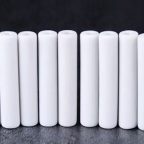Ceramic materials are typical hard and brittle materials. Before the mid-to-late 20th century, people thought that zirconia ceramic materials could not be processed or could not be processed, so they could only be processed into the desired shape when making green bodies, and then used directly after firing. The reason for removing the hard and brittle characteristics of the ceramic material itself is mainly due to the lack of machining tools and machining methods at that time. Although people have discovered superhard materials such as diamond and vertical boron nitride that are much harder than ceramic materials, the machining of ceramic materials has only been developed in recent decades. The grinding process of hard and brittle ceramic materials was realized only after it was made into a machining tool and a suitable machining method was found. After entering the 21st century, it has developed into precision machining and micro-nano machining.
Ceramics are generally a polycrystalline multiphase material structure containing a glass phase and a pore phase. The vast majority of ceramics are compounds composed of one or several metallic elements and non-metallic elements. According to their properties and uses, ceramics can be divided into traditional ceramics and special ceramics. With the development of modern technology, alumina ceramics are constantly given new names and definitions, such as fine ceramics, high-performance ceramics, and advanced ceramics. Traditional ceramics are made of natural silicate minerals after crushing, molding and sintering. They are mainly used for daily-use ceramics, architectural ceramics and sanitary ceramics. Although they are required to be non-deformed and beautiful after sintering, they do not require high strength. . Engineering ceramics are made from synthetic compounds (such as oxides, nitrides, carbides, borides, etc.) and are mainly used in technical and industrial fields.
Engineering ceramics are divided into structural ceramics and functional ceramics. Functional ceramics are mainly developed and used according to their different functional applications. As the focus of research, structural ceramics mainly refer to ceramic materials used in load-bearing, high temperature resistance, corrosion resistance, wear resistance and other occasions. Silicon nitride ceramics are widely used in machinery, energy, electronics, chemicals, petroleum, automobiles, aerospace and aviation. and other fields. Structural ceramics fall into two broad categories: oxide ceramics and non-oxide ceramics.
Oxide ceramics are compounds formed by the combination of metal elements and oxygen. The chemical bonds between atoms are mainly ionic bonds, so the melting point of these compounds is not very high, and the hardness, strength and toughness are also different. There are simple oxides and complex oxides, the former such as zirconia (2r02), alumina (Al203), etc., the latter such as mullite (3Al203.2SiO2).
Compounds composed of non-metal elements B, C, N combined with metal elements Al, Si, Zr, Hf, etc. are called non-oxide ceramics, which have high melting points, strong covalent bonds and many other excellent mechanical properties. In particular, some typical ceramic materials such as S13 N4 and SiC are widely used. Non-oxide ceramics have the following common characteristics:
- (1) Non-oxide ceramics are generally compounds with strong covalent bonds and refractory.
- (2) The development history of non-oxide ceramics is relatively short. For example, after the discovery of nitride ceramics with good mechanical, thermal and electrical properties in the 1950s, nitride ceramics have received increasing attention and attention.
- (3) Different from oxide ceramics, the raw materials of non-oxide ceramics do not exist in nature and need to be artificially synthesized, and then prepared into various ceramic products according to the ceramic process.
- (4) Non-oxide ceramics are easily oxidized. From raw material preparation, ceramic sintering until in use, oxidation reaction will occur when encountering oxygen and transform into oxides.
The formation of oxides will affect the high temperature properties of the material. Therefore, raw material synthesis of silicon carbide ceramics and ceramic sintering need to be carried out in an oxygen-free atmosphere, usually nitrogen, argon or vacuum atmosphere. After firing the ceramic, it can be used at a higher temperature due to its certain oxidation resistance. Different materials of aluminum nitride ceramics have different oxidation resistance, and their maximum operating temperature also varies according to the material. Oxidation when used at high temperatures will affect the service life of the material.
Pintejin machining ceramic service include : Alumina Ceramic Parts, Zirconia Ceramic, Silicon Carbide Ceramic, CNC Machined Aluminum Nitride Ceramic, Machinable Ceramic Parts, Glass Ceramic,Macor Ceramic,Powder Metallurgy Dies,Ceramic Injection Molding,Ceramic Dry Pressing,Ceramic Extrusion Dies




